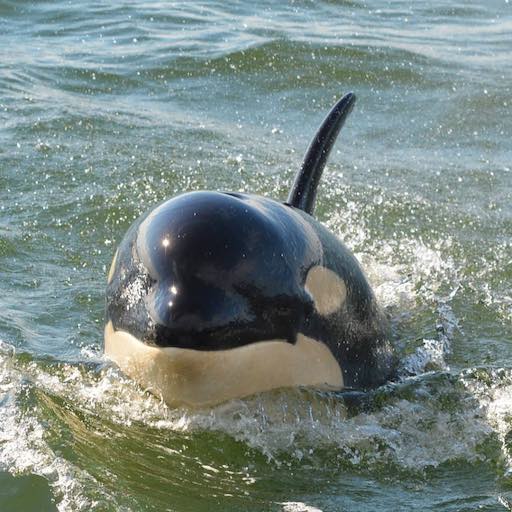forum
library
tutorial
contact

Gov. Jay Inslee's Orca-Recovery Agenda Advancing,
But Billion-Dollar Funding Yet to Be Seen
by Lynda V. Mapes
Seattle Times, April 19, 2019
|
the film forum library tutorial contact |

|
Gov. Jay Inslee's Orca-Recovery Agenda Advancing,
by Lynda V. Mapes
|
"I know it's controversial but I think we need to have the hard conversations," Amy Windrope said.
 Gov. Jay Inslee's orca agenda is advancing in the Washington state Legislature, but with the budget yet to be decided how much of the governor's billion-dollar-bold ambition will be accomplished is yet to be seen.
Gov. Jay Inslee's orca agenda is advancing in the Washington state Legislature, but with the budget yet to be decided how much of the governor's billion-dollar-bold ambition will be accomplished is yet to be seen.
Budgets passed by the House and Senate so far contain no funding to continue the governor's task force on orca recovery. There's no agreement yet on funding the governor's proposed panel to consider the affects of breaching the Lower Snake River dams. And revenue measures to help pay for everything, from increasing hatchery production to enforcement of habitat protections, have yet to be decided.
There also were policy disappointments for the governor, who got no takers for his request for legislation to put a temporary stop on whale watching of southern resident killer whales; no lawmaker would introduce the bill. A vessel noise-reduction package will take years to implement with rule making yet to be done, and because U.S. Coast Guard regulations include important exemptions, including for commercial shipping that makes most of the noise that can disrupt orcas as they hunt.
But the Legislature did pass its most comprehensive package of orca-recovery legislation ever, with four key measures intended to address the three core threats to the southern resident killer whales that frequent Puget Sound. The orcas are headed toward extinction because of lack of prey, especially chinook salmon; disturbance caused by vessel noise and boats; and toxics. Lawmakers also adopted long awaited improvements in habitat protection for shoreline areas, and to protect against oil spills.
The initiatives grew out of the governor's task force on orca recovery which made after a year of work undertaken by more than 40 members.
Differences on the bills are still being worked out in conference committees and funding for implementation is still up in the air. But the following bills appear certain to head to the governor's desk for signature:
Toxics are one of the key threats to orca survival. When the orcas are hungry, they burn fat where toxics are stored, releasing those poisons to their blood where they can disrupt endocrine function and depress the whales' immune system.
Hardening shorelines destroys nearshore habitat that provides a crucial travel corridor and nursery ground for young salmon. Beaches also are where crucial forage fish, including sand lance and surf smelt, spawn. Those fish feed the salmon that orcas depend on.
One of the biggest threats to orcas is lack of adequate salmon, largely due to loss of suitable habitat to sustain salmon survival. Fixing salmon habitat is vital to orca recovery.
The budget is where key decisions still lie ahead affecting orcas.
So far the budget does include money to pay for rule-making and environmental review of increased spill over dams on the Columbia and Snake rivers in order to aid migration of juvenile salmon to the sea during the spring runoff.
Increasing spill is regarded as one of the single most effective tools to boost juvenile-salmon survival in the Columbia and Snake and is sought under a new agreement signed last year by the Bonneville Power Administration (BPA), Nez Perce Tribe and state of Oregon. The so-called flexible spill agreement is a new approach that allows BPA to sell power when it can make the most money but spill more water when power rates are lower to benefit fish.
The fate of another key element in the governor's orca agenda is still to be determined in budget negotiations. A panel to assess the affects of taking out the Lower Snake River dams is funded in the Senate version of the budget, but so far not in budget passed by the House.
The panel is intended to examine the benefits and costs and changes to be expected if four dams on the Lower Snake were removed to boost salmon recovery. The southern residents hunt salmon over a vast territory and depend on salmon from the Columbia and Snake, especially in the early spring when food is scarce elsewhere in their migratory range.
Scientists in a letter last October advised the orca task force, Inslee and lawmakers that salmon recovery in the Snake River is key to orca survival and that dam removal is a key step to boost both salmon and orca recovery. However, eastern Washington lawmakers and local Eastern Washington port officials have been seeking to block Inslee's proposal.
Amy Windrope, assistant director of the Washington Department of Fish and Wildlife and a member of the orca task force, said dam removal came up at every task-force meeting. "I know it's controversial but I think we need to have the hard conversations," Windrope said.
The work still ahead before the Legislature's adjournment scheduled for April 30 will be critical to realizing a holistic approach to orca recovery, Windrope said. "These really are steps in the right direction. There are still big question marks around funding."
learn more on topics covered in the film
see the video
read the script
learn the songs
discussion forum
